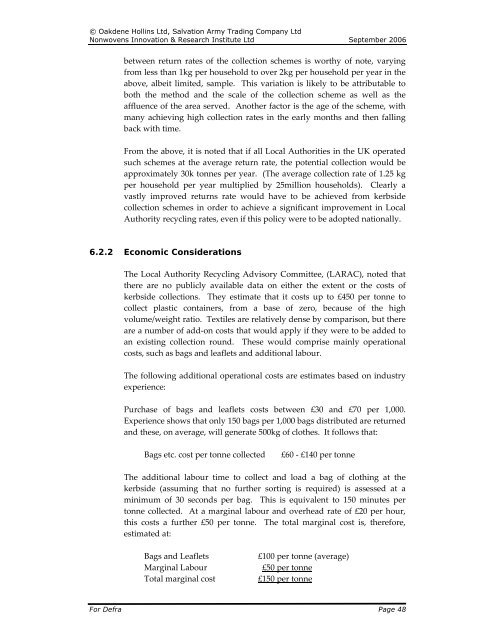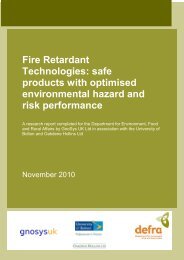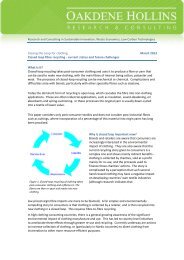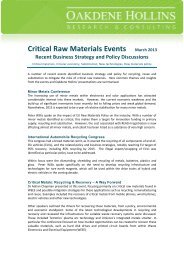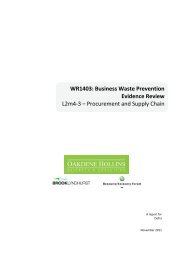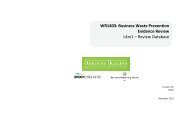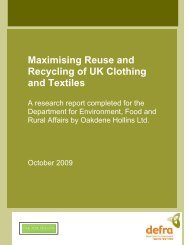Recycling of Low Grade Clothing Waste - Oakdene Hollins
Recycling of Low Grade Clothing Waste - Oakdene Hollins
Recycling of Low Grade Clothing Waste - Oakdene Hollins
You also want an ePaper? Increase the reach of your titles
YUMPU automatically turns print PDFs into web optimized ePapers that Google loves.
© <strong>Oakdene</strong> <strong>Hollins</strong> Ltd, Salvation Army Trading Company Ltd<br />
Nonwovens Innovation & Research Institute Ltd September 2006<br />
between return rates <strong>of</strong> the collection schemes is worthy <strong>of</strong> note, varying<br />
from less than 1kg per household to over 2kg per household per year in the<br />
above, albeit limited, sample. This variation is likely to be attributable to<br />
both the method and the scale <strong>of</strong> the collection scheme as well as the<br />
affluence <strong>of</strong> the area served. Another factor is the age <strong>of</strong> the scheme, with<br />
many achieving high collection rates in the early months and then falling<br />
back with time.<br />
From the above, it is noted that if all Local Authorities in the UK operated<br />
such schemes at the average return rate, the potential collection would be<br />
approximately 30k tonnes per year. (The average collection rate <strong>of</strong> 1.25 kg<br />
per household per year multiplied by 25million households). Clearly a<br />
vastly improved returns rate would have to be achieved from kerbside<br />
collection schemes in order to achieve a significant improvement in Local<br />
Authority recycling rates, even if this policy were to be adopted nationally.<br />
6.2.2 Economic Considerations<br />
The Local Authority <strong>Recycling</strong> Advisory Committee, (LARAC), noted that<br />
there are no publicly available data on either the extent or the costs <strong>of</strong><br />
kerbside collections. They estimate that it costs up to £450 per tonne to<br />
collect plastic containers, from a base <strong>of</strong> zero, because <strong>of</strong> the high<br />
volume/weight ratio. Textiles are relatively dense by comparison, but there<br />
are a number <strong>of</strong> add‐on costs that would apply if they were to be added to<br />
an existing collection round. These would comprise mainly operational<br />
costs, such as bags and leaflets and additional labour.<br />
The following additional operational costs are estimates based on industry<br />
experience:<br />
Purchase <strong>of</strong> bags and leaflets costs between £30 and £70 per 1,000.<br />
Experience shows that only 150 bags per 1,000 bags distributed are returned<br />
and these, on average, will generate 500kg <strong>of</strong> clothes. It follows that:<br />
Bags etc. cost per tonne collected<br />
£60 ‐ £140 per tonne<br />
The additional labour time to collect and load a bag <strong>of</strong> clothing at the<br />
kerbside (assuming that no further sorting is required) is assessed at a<br />
minimum <strong>of</strong> 30 seconds per bag. This is equivalent to 150 minutes per<br />
tonne collected. At a marginal labour and overhead rate <strong>of</strong> £20 per hour,<br />
this costs a further £50 per tonne. The total marginal cost is, therefore,<br />
estimated at:<br />
Bags and Leaflets<br />
Marginal Labour<br />
Total marginal cost<br />
£100 per tonne (average)<br />
£50 per tonne<br />
£150 per tonne<br />
For Defra Page 48


